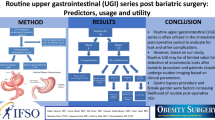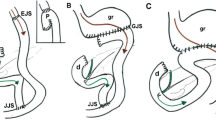Background: Radiologic contrast studies have been used routinely to rule out gastrointestinal (Gl) leaks and to evaluate gastric emptying after bariatric surgery. The aim of the study was to evaluate the value of this study in the diagnosis of early complications. Patients and Methods: 100 morbidly obese patients underwent bariatric surgery at our institution in a 7-year period. An upper GI series was routinely performed 48 to 72 hours after surgery. Clinical and radiologic records were reviewed, analyzing demographic characteristics, type of surgery, radiologic findings, and clinical evolution with emphasis on the presence of leaks. Results: Mean age was 36 ± 10 years; there were 68 women and 32 men. Mean body mass index (BMI) was 48 ± 10 kg/m2. All radiologic examinations ruled out the presence of leaks and showed adequate gastroesophageal emptying. One patient with normal postoperative x-ray studies developed a small GI fistula after starting liquid diet. Conclusions: Contrast radiologic studies permit good visualization of the gastric anatomy after bariatric surgery. They usually confirm adequate gastric emptying, but might be unable to demonstrate small gastric leaks.
Similar content being viewed by others
Author information
Authors and Affiliations
Rights and permissions
About this article
Cite this article
Ganci-Cerrud, G., Herrera, M.F. Role of Radiologic Contrast Studies in the Early Postoperative Period After Bariatric Surgery. OBES SURG 9, 532–534 (1999). https://doi.org/10.1381/096089299765552611
Published:
Issue Date:
DOI: https://doi.org/10.1381/096089299765552611




